A Brief History of Montana in 20 Icons
Compiled by Valerie Harms

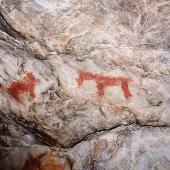
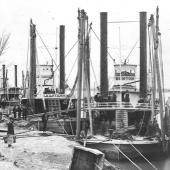
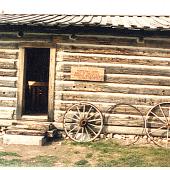
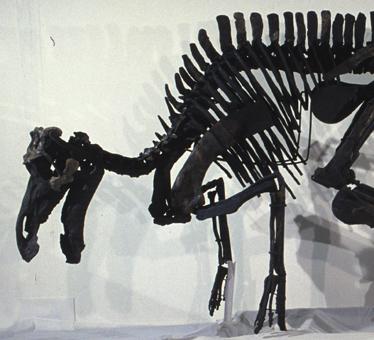
These icons represent a fraction of Montana’s tumultuous history. We invite you to send your personal favorites (along with a picture is best) [email protected]
1. “The Arrival of Captain Lewis at the Great Falls of the Missouri – June 13, 1805,” oil painting by Billings artist Charles Fritz (42" x 65"). The crown of Montana history, In 1800, President Thomas Jefferson supported the purchase of “French Louisiana” and initiated the Lewis and Clark Expedition to explore the lands all the way west to the Pacific. They found a rich and beautiful land. When Captain Lewis came to the Great Falls, he is said to have spent two hours staring at it.
2. Pictograph – Pictographs were made by native people in caves up to 14,000 years ago to tell stories to their progeny. Photo by Joe Gutkoski.
3. Judith Gap windfarm. Dedicated in 2005, this ambitious project represents the future of sustainable energy in the new economy of Montana. Now Montana has seven wind farms. In 2009, the Glacier Wind Farm became the largest. In 2012, two others were started — the Rim Rock Wind Farm and the Gordon Butte Wind Farm — making this year the highest in wind energy generation yet.
4. Maiasaura – This duck-billed dinosaur lived 78 million years ago along the east side of the then young Rocky Mountains. Named by Montana paleontologist John R. Horner, it means “good mother lizard.” At birth it measured 14 inches and full-grown 30 feet long and three tons in weight. It became the State Fossil of Montana.
5. River steamer “Benton.” Immigrants came to Montana by steamboat, in wagons, on horseback and on foot. Those that could afford it rode into Montana by steamboat up the Missouri River to Fort Benton. The first steamboat to arrive on the Missouri River was in 1860. The town boomed as a hub for the entire region.
6. In 1862, Montana’s Gold Rush began. (gold pix.) By the late 1870s mining camps dotted nearly 500 gulches. Little Montana towns sprouted and just as quickly died. No longer was the economy based on furs or trade goods. A boom-or-bust pattern emerged.
7. John Bozeman’s knife. With a bone handle and leather sheath, this knife represents the style trappers used. It’s of iconic value to montana's history because the town and the famous Bozeman Trail, opened in 1863, are named after the man. The knife was buried with him.
8. Homestead near Stevensville. In 1862, the federal government gave away 52 million acres for free in the Homestead Act to encourage small farmers to populate the land. By 1886 two million homesteaders arrived. They were young men, single women, and lots of children. Almost all misunderstood Montana’s climate. The land grab ended any sense of frontier. The homesteaders’ plows ruined the native grasslands and the game animals greatly diminished. In 1889 Montana was declared a state. Stevensville remains an iconic montana town.
9. Indian ledgers in color – While in 1855 tribal nations were firmly established across Montana, soon the American Indians and Euro-Americans were in collision and at war. The Indians were displaced by the destruction of the bison, disease, and treaties that were not lived up to. The government wanted to protect its right to expand (“manifest destiny) and pushed the natives aside for the sake of mines, towns, lumber camps, and railroads. The Indians told stories of these events on paper, muslin, canvas and hides with colored pencils and paints. This art is more colorful and detailed than pictographs. (p.145)
10. Sheepherders’ wagon. Sheep came to Montana about the same time cattle did and at first both industries enjoyed the open range. (The coming of barbed wire in 1868 changed that.) Sheepherders tended their flock all winter, cooking and sleeping in their wagons. Multilayered canvas tops kept them warm. Inside they had a stove, dishes, cupboard, and bed. When it was time to move the flock to a new grazing ground, the herder hitched the wagon to a team of horses and moved camp. A sheepherder’s best friend most likely was a dog.
11. Mine interior by R. Gibson. Some of the richest veins of copper in the world lay under the Butte hill. Copper was used in electric motors, telephones, and power lines. As the world’s demand increased, Butte’s mines expanded. This photograph represents the mines and the enormous amounts of lumber required in building the frames. Notice the thick beams. The lumber industry developed along with mining.
12. Helena Capitol. In 1894, Helena narrowly won the vote to be state capital amongst several other montana towns. The statue in front of the Capitol is of General Thomas Francis Meagher who served as territorial governor from 1865-7. Because Irish immigrants raised the money to erect the statue, it is symbolic of the Irish presence in Montana. Paul Wylie, author of The Irish General, can be seen in front of the statue.
13. Manhattan plant, 1880-1916. Grain elevators dot Montana’s landscape because Montana excels in supplying the world with grains. A grain elevator consists of a tower containing a bucket elevator, which scoops up grain from a lower level and deposits it in silo or other storage facility. A grain elevator may also have included receiving, weighing, and testing offices. It was necessary to build them near the railroads for easy transport.
14. The Going-to-the-Sun Road, opened in 1933, is one of Montana’s most spectacular constructions and a exciting period of Montana history. It traverses 56 miles across Glacier National Park and climbs 6,400-foot Logan Pass to connect the east and west sides of the park. Workers sometimes had to climb 3,000 feet just to start their work, and snowdrifts could be 60 feet deep in winter. If we sometimes find the road scary to drive on, imagine how much more so it was for the workers. In this 1928 photo the men are removing snow from a deep gulch to begin construction of two retaining walls.
15. Wilderness acts. By the mid 1900s, a conservation movement got going. While people generally thought of the land in terms of its resources, it took those like Bob Marshall and Senator Lee Metcalf and their supporters who saw the value in protecting Montana’s remaining wilderness from development. By 1978, “the Bob” protected 1.5 million acres. The Montana Wilderness Study Act provided a layer of protection — not full wilderness designation — for about 700,000 acres.
16. Spirit of Montana label. In the 20th century the Old West began to morph into the New West. More rural Montanans left the farms and moved to town. The interstate highways laced the state, reducing the need for trains and stimulating tourism. The natural resource economy shifted to a service economy. Small businesses like this one play a big part in independent Montanans’ lives and the label became an icon of Montana history.
17. Indian cradleboard or dress FILL IN. Prior to 1700 the tribes had complex transportation routes all over the abundant plains. People lived in tipis held down by stones. (Stone circles can still be found around Montana.) They wore clothing of soft animal skin — loose straight dresses for women and leggings for men. Moccasins were made of deer hide. Women carried their babies in cradleboards (carriers with wooden frames). Fine artwork in daily items
18. Paradise café. Montanans love classic cafes and cars. They dot our landscape and we feel a tug at our hearts when we see them. Then we stop and go inside the cafes to eat good food and maybe to dance. They have terrific names — one of the best is the “Road Kill Café” (McLeod). Other favorite places are the Polebridge Mercantile and Virgelle Mercantile.
19. Anaconda Standard newspaper headline.The two richest copper tycoons were Marcus Daly and William A. Clark; although both Democrats, they seemed to disagree about everything else. Daly connived to defeat Clark in several elections. In 1899, Clark notoriously tried to hand out $1000 bills to buy legislators’ vote for a seat in the Senate, spending one million dollars in bribes. A Senate investigation found him guilty and denied him the seat. But after Daly’s death, in 1901 Clark went unchallenged for the seat.
20. Northern Pacific train. In the 1890s the railroad needed money to complete its lines across Montana and the continent. They launched an aggressive campaign to get people to settle in Montana, planning to receive income from shipping crops and livestock to market. Northern Europeans were targeted because of the similar climate; as a result, a tidal wave of homesteaders arrived, including many of Montana’s immigrants. The town of Livingston was founded by the Northern Pacific RR.
















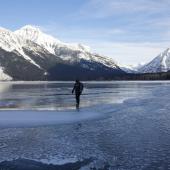
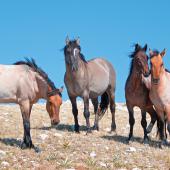
Leave a Comment Here